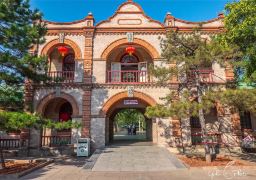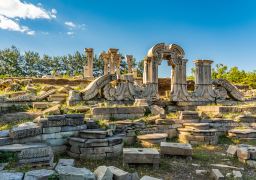A rich variety of classic repertoires span 300 years of classical music, revisiting romantic classics and enjoying a soul-stirring audio-visual feast.
Classical music, originating from the Baroque period to the early 20th century within the European cultural tradition, is distinct from popular music and is an independent genre of music that pursues refined artistic techniques and emphasizes the rational expression of emotions. Classical music themes are rich and ubiquitous, providing beautiful melodies that can elevate our souls. After centuries of refinement, classical music still exudes a charming fragrance, widely circulated around the world, allowing people from different eras, genders, and ethnicities to appreciate its beauty and resonate with its spirit. The performance blends a variety of Chinese and foreign classics, encompassing both the grand and powerful major mode as well as the sorrowful and tender minor mode, featuring Beethoven’s ‘Ode to Joy’ and ‘Für Elise’, Johann Strauss’s ‘The Blue Danube’, offering the audience a top-tier audio-visual feast. Classical music, with its tranquility and serenity, creates an otherworldly realm not found in real life, providing complete rest for those who are constantly competing, busy, and anxious. Many classical music pieces express a sublime and majestic beauty that is generally lacking in popular music. This sense of loftiness and sanctity can perhaps only be found in classical music today! The Philharmonic Light Orchestra will regularly present exciting classical world masterpiece concerts at the Sanlitun • Philharmonic Light Art Space – City Concert Hall. This concert will bring you renowned Chinese and foreign classical masterpieces such as ‘Ode to Joy’, ‘Für Elise’, ‘Canon in D Major’, and ‘The Second Waltz’. The musicians will take you on a journey to enjoy the beautiful classical music and deeply feel the romantic moments it brings to us. ———Music Popular Science———- Canon in D Major – Composed by Johann Pachelbel (Germany) The ‘Canon in D Major’ was composed during the Baroque period, where melodies in Baroque music continuously expand and unfold, with a rhythm that is fluid and cyclic, creating a sense of space and three-dimensionality. This piece begins with a cello introduction, providing harmonic support to the melody. The rich and deep sound of the cello symbolizes the underlying tone of history, calm and profound; the recurring cello notes throughout represent the ever-flowing time that is always moving forward, the best witness to all the joys and sorrows, partings and reunions in life.A foreign music enthusiast’s comment on Canon is: ‘It can make me feel a shiver that penetrates the spine, reaching the soul.’
Turkish March – Mozart (Austria) Unlike Bach’s balanced perfection and Beethoven’s untamed spirit, Mozart’s works encompassed all musical genres of his time. The concertos, symphonies, sonatas, serenades, and divertimentos he composed later became the main forms of classical music. The theme of the piece is simple and extremely rhythmic, with eighth notes maintaining a consistent rhythm, enhanced by sixteenth notes to increase liveliness, presenting a kind of innocence akin to childhood. The title of this piece, derived from its imitation of Turkish military band music, is ‘Turkish March,’ and its march-like style is inevitably present. The first episode presented at the beginning uses an echo-like pattern and nimble grace notes, moving briskly in a tight-then-loose rhythm, possessing characteristics of both a march and a dance. It showcases the energetic progression of an army. Ode to Joy – Beethoven (Germany) The rhythm and melody are simple and clear, a tune that can be hummed anytime, anywhere. Perhaps this is Beethoven’s hint that the most sublime and beautiful things often appear in the most ordinary places. Ode to Joy’s lively and clear melody is filled with a festive atmosphere, representing hope and joy, appearing as a hymn in every joyful season. Ode to Joy is a vast set of variations, with the addition of orchestral music bringing a sense of strength and determination. The entire hymn seems like a ray of sunlight breaking through dense clouds and shining on the earth. Through this work, Beethoven expressed humanity’s struggle for freedom and his belief in the inevitable attainment of joy and unity. About Music Fans Classical Orchestra Music Fans Classical Orchestra (MFC Orchestra) is a brand-new ensemble that transcends classical and popular music, combining tradition with fashion. MFC Orchestra is very young, founded and debuted in 2015. Unlike the most common and mature string quartets and other chamber ensembles in the world, MFC Orchestra’s regular formation consists of seven members, ingeniously adding piano, clarinet, and percussion to the string quartet. Musically, the orchestra retains classical styles while adding contemporary pop elements. Looking across the entire Chinese music scene and the world, such a cross-over performing group can be considered unconventional and unique.Their performance forms are eclectic, full of youthful vitality, and the repertoire styles are diverse, including classical music, classic film music, folk music, dance music and jazz music. The Mphil Chamber Orchestra is a light music orchestra with classical music performance ability that Mphil focuses on creating. Mphil itself is a pioneer in China’s entertainment performance industry. Its purpose is to bring concerts that ordinary people can afford and understand. Therefore, an original orchestra established under a professional performance organization is bound to break the inherent impression that classical music is highbrow and hard to reach. Every year, they tour more than 50 cities, with more than 3,000 performances and an audience of over ten million people. In the Chinese performance market, the Mphil Chamber Orchestra has always been popular. The orchestra takes live performances as the main breakthrough point, spreads and popularizes live performing arts with strength, breaks the inherent impression that pure music art is highbrow and hard to reach, and gains a lot of praise and love. Venue: ‘Let music go to the public. A new landmark for checking in in Sanlitun, Beijing. Between the black and white keys, the life performance echoes.’ (Sanlitun · Mphil Art Space – City Concert Hall). Between the black and white keys, the life performance echoes. The style of Sanlitun · City Concert Hall combines classical and modern. With an excellent geographical location, it realizes the concert around you. Not only is the geographical location excellent, but it also brings concerts that ordinary people can afford and understand. Repertoire Preview: 1. The Blue Danube – work by Johann Strauss Jr. 2. Swan Lake – work by Pyotr Ilyich Tchaikovsky 3. Dance of the Little Swans – work by Pyotr Ilyich Tchaikovsky 4. Canon in D Major – work by Johann Pachelbel 5. Carmen Overture – work by Georges Bizet 6. Csárdás – selected from the work of Vittorio Monti 7. Turkish March – work by Mozart 8. Für Elise – work by Beethoven 9. Ode to Joy – work by Beethoven 10. Second Waltz – work by Shostakovich
March of the Toreadors – Work by Pascual Marquina Narro. Full text. Opening hours: November 9 – December 22. The performance time and duration are subject to the site.









